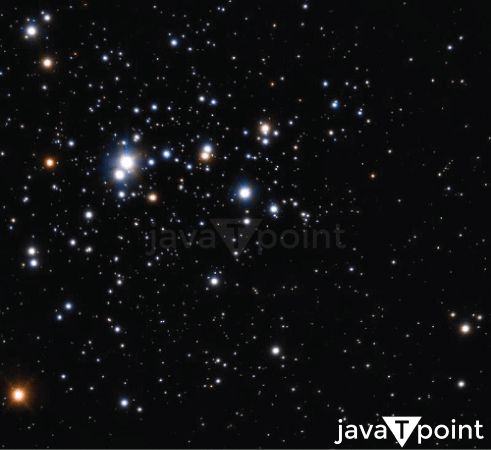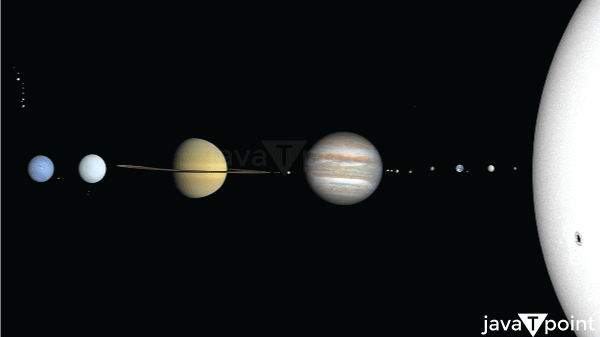Difference between Stars and Planets
Introduction:
Stars and planets are two distinct celestial objects found in our universe. While gazing at the vast night sky, you can see celestial objects far away and far larger in size than our minds can comprehend, shining in the sky. Even though they look alike from the earth, they can be broadly categorized into two distinct types: stars and planets. These celestial entities have fundamentally different characteristics, origins, and roles in the cosmos. Before diving into the differences, we must understand what really these celestial objects are and what significance these astronomically distant objects have.

Stars:

Stars are celestial objects that are incredibly luminous and emit their own light and heat due to nuclear fusion reactions occurring in their cores. They are one of the universe's building blocks and play a central role in the structure and dynamics of galaxies like our Milky Way.
Here are some key characteristics and information about stars:
- Composition:
Stars are primarily composed of hydrogen and helium, the two lightest elements in the universe. These elements are fused together in the extreme conditions found in a star's core to produce heavier elements and release energy.
- Formation:
Stars form from the gravitational collapse of massive clouds of gas and dust in interstellar space. As these clouds contract under gravity, they heat up and eventually reach the temperatures and pressures required for nuclear fusion to ignite in their cores.
- Nuclear Fusion:
Nuclear fusion is the energy-producing process at the heart of a star. In a star's core, hydrogen atoms fuse together to form helium, releasing enormous energy in the form of light (photons) and heat. This energy generation is what makes stars shine.
- Life Cycle:
Stars go through a life cycle that depends on their mass. Low-mass stars, like red dwarfs, burn their fuel slowly and can shine for billions or even trillions of years. Higher-mass stars, like our sun, have shorter lifespans, typically a few billion years. Massive stars have even shorter lifespans, often only a few million years.
- Stages of Evolution:
Stars evolve through various stages during their lifetime, with the specific path determined by their mass. For example, our sun is currently in the "main sequence" phase, where hydrogen fusion predominates. As stars exhaust their hydrogen fuel, they expand into red giants or supergiants before undergoing further transformations.
- Death and Supernovae:
Depending on their mass, stars end their lives in different ways. Like our sun, low- and medium-mass stars eventually shed their outer layers to become white dwarfs. Massive stars can undergo supernova explosions, which release immense energy and scatter heavy elements into space. The remnants of supernovae can form neutron stars or even black holes.
- Importance in the Universe:
Stars are essential to the formation of planetary systems. Planets, including our own Earth, form from the material left over after a star's formation. Stars also play a crucial role in synthesizing elements beyond hydrogen and helium. Elements heavier than helium, including carbon, oxygen, and iron, are produced in the cores of stars and then released into space during supernova explosions. These elements are the building blocks of planets, life as we know it, and the entire universe.
- Variety:
Stars come in various sizes, colors, and brightness. They can be classified into different spectral types (e.g., O, B, A, F, G, K, M) based on their surface temperatures, with O-type stars being the hottest and M-type stars being the coolest.
Our understanding of stars and their life cycles has greatly expanded through astronomical observations and theoretical models, and stars continue to be a subject of fascination and research in the field of astrophysics.
Planets:

Planets are fascinating celestial bodies that orbit stars, including our own sun, in the vast expanse of space. They are an integral part of our solar system and the universe. Here are some key aspects of planets:
1. Definition and Characteristics:
- Orbiting Stars: Planets are celestial objects that revolve around stars. In our solar system, the sun is the star around which planets orbit.
- Spherical Shape: Planets are nearly spherical due to their gravity. This shape allows them to maintain hydrostatic equilibrium, meaning their internal forces balance out the gravitational forces acting upon them.
- Cleared Their Orbits: One of the key criteria used to classify objects as planets is that they must have cleared their orbits of other debris, meaning they have become gravitationally dominant in their regions.
2. Types of Planets:
In our solar system, there are three primary types of planets:
- Terrestrial Planets: These planets are rocky and relatively small. Mercury, Venus, Earth, and Mars are considered terrestrial planets. They have solid surfaces, and Earth, in particular, is known for its diverse ecosystems and the presence of water.
- Gas Giants (Jovian Planets): These planets are predominantly gas and much larger than terrestrial planets. Jupiter and Saturn are gas giants in our solar system. They lack solid surfaces and are characterized by thick atmospheres and numerous moons.
- Ice Giants: Uranus and Neptune are sometimes referred to as ice giants. They are composed of a mixture of gas and ice and have distinct characteristics from gas giants.
3. Formation:
Planets form from the leftover material surrounding a young star after its formation. This process begins in a protoplanetary disk of gas and dust, where particles collide and stick together, gradually forming planetesimals and then protoplanets. Over millions of years, these protoplanets can grow into full-fledged planets through accretion and gravitational attraction.
4. Moons:
Many planets have natural satellites or moons that orbit around them. Earth, for example, has one moon, while gas giants like Jupiter and Saturn have numerous moons. These moons come in various sizes and have diverse characteristics.
5. Atmospheres:
Planets can have a wide range of atmospheres, each with its own composition and characteristics. Earth's atmosphere, for instance, is primarily composed of nitrogen and oxygen and is essential for supporting life. Gas giants like Jupiter have thick, turbulent atmospheres composed mainly of hydrogen and helium.
6. Exploration:
Throughout history, humans have been intrigued by planets and their mysteries. The exploration of planets, both within our solar system and beyond, has been a significant focus of space exploration efforts. Notable missions include the Apollo moon landings, the Mars rovers, and missions to outer planets like Voyager and Cassini-Huygens.
Difference between Stars and Planets:
Stars and planets are two distinct celestial objects found in our universe, and they have several key differences:
1. Formation and Composition:
- Stars: Stars are primarily composed of hydrogen and helium, the two lightest elements in the universe. They form from the gravitational collapse of gas and dust in interstellar clouds. The immense pressure and temperature at their cores allow nuclear fusion to occur, producing energy in light and heat. This is what makes stars shine.
- Planets: Planets, on the other hand, form from the leftover material surrounding a star after its formation. They consist of a variety of elements and compounds, including heavy metals, rocks, and gases. Planets do not undergo nuclear fusion and do not emit their own light; instead, they reflect the light from their parent star.
2. Size:
- Stars: Stars are significantly larger than planets. They can range in size from a fraction of the size of the sun (dwarf stars) to many times larger than our sun (giant stars).
- Planets: Planets are much smaller than stars. Even the largest planets, like Jupiter, are much smaller in size and mass than the smallest stars, like red dwarfs.
3. Light and Heat Emission:
- Stars: Stars emit their own light and heat due to nuclear fusion reactions occurring in their cores. This is what makes them visible from great distances and why they appear as points of light in the night sky.
- Planets: Planets do not generate their own light or heat. They reflect the light of their parent star (sunlight) and emit some heat that they have retained from their formation and radioactive decay, but this is relatively small compared to the heat generated by stars.
4. Motion:
- Stars: Stars appear as fixed points of light in the night sky but also have their own motion through space. However, their motion is generally less noticeable over human timescales compared to planets.
- Planets: Planets are visible in the night sky because they move relative to the background of stars. They follow predictable paths known as orbits around their parent star.
5. Number in the Universe:
- Stars: There are hundreds of billions of stars in our galaxy (the Milky Way) alone and billions of galaxies in the observable universe, each containing numerous stars.
- Planets: The number of planets in the universe is likely much greater than the number of stars, given the potential for planets to exist around most stars. However, precise counts are challenging due to limitations in observation technology.
In summary, stars are massive celestial objects that emit their own light and heat through nuclear fusion, while planets are smaller objects that do not generate their own light or heat and instead reflect the light of their parent star. These differences in size, composition, and behavior distinguish stars from planets.
Correlation between Stars and Planets:
Stars and planets are intimately connected within a solar system, and their existence and characteristics are influenced by each other. Here are several key correlations between stars and planets:
- Formation from the Same Nebula:
Both stars and planets form from the same giant molecular cloud or nebula of gas and dust within a galaxy. These clouds contain the raw materials from which both stars and planetary systems emerge.
- Gravitational Interaction:
Stars and planets interact gravitationally. The star's gravitational pull keeps planets in orbit around it. Simultaneously, the gravitational pull of the star affects the orbits and motions of the planets.
- Energy Source:
Stars, including our Sun, are the primary sources of energy for planets within their solar systems. Stars emit light and heat through nuclear fusion reactions in their cores, providing the energy necessary for planetary climates and ecosystems.
- Planetary Formation:
Planets form through processes within the protoplanetary disk surrounding a young star. The gravitational influence and radiation pressure from the star play a crucial role in shaping the composition and orbital dynamics of planets.
- Planetary Orbits and Habitability:
The distance of a planet from its parent star, known as its orbital radius, directly affects its climate and potential habitability. Planets within a star's habitable zone, where conditions are right for liquid water to exist, are more likely to support life.
- Solar Radiation and Atmospheres:
Stars provide the energy that powers the atmospheres of planets. The interaction between the star's radiation (e.g., sunlight) and the planet's atmosphere determines its temperature, weather patterns, and the possibility of sustaining life.
- Tidal Forces:
Stars exert tidal forces on their planets due to gravitational interactions. These forces can lead to phenomena such as tidal heating, which can affect a planet's geological activity, as seen in the case of Jupiter's moon Io.
- Stellar Lifecycles and Planetary Fate:
The lifecycle of a star, including its mass and eventual evolution, can influence the fate of any planets in its orbit. For instance, massive stars may undergo supernova explosions, which can impact nearby planets and lead to the formation of neutron stars or black holes.
- Stellar Energy Variability:
Variability in a star's energy output, such as solar flares and changes in luminosity, can have a significant impact on the atmospheres and surface conditions of planets. For example, extreme solar flares from a star could strip away a planet's atmosphere.
- Exoplanet Research:
The study of exoplanets (planets outside our solar system) often involves examining the characteristics of the host star. Information about a star's size, mass, temperature, and brightness is crucial in understanding the properties of orbiting exoplanets, including their potential for habitability.
In summary, stars and planets are interrelated components of a solar system, and their characteristics, formation, and behaviors are deeply connected. The study of this interplay provides insights into the formation and evolution of both stars and planets and enhances our understanding of the broader universe.
Brief History of Astronomy:
The study of stars, known as astronomy, has a rich and ancient history that spans thousands of years. Here is a brief overview of the history of star study:
1. Ancient Civilizations:
- Babylonians and Sumerians (circa 2000 BC): These ancient civilizations in Mesopotamia made some of the earliest recorded observations of the night sky. They were particularly interested in tracking the movements of celestial objects, including stars, to create calendars and predict astronomical events.
- Ancient Egyptians (circa 3000 BC): The Egyptians used their knowledge of the stars for religious and practical purposes. They aligned their pyramids and temples with celestial bodies and developed calendars based on the movements of the stars.
- Ancient Greeks (circa 600 BC to 300 BC): Greek philosophers and astronomers made significant contributions to the understanding of the cosmos. Early Greek philosophers such as Thales and Anaximander speculated about the nature of the stars and their place in the universe. Later Greek astronomers, including Hipparchus and Ptolemy, developed models to explain the motions of celestial objects, including the stars, based on a geocentric (Earth-centered) view of the universe.
2. Medieval and Renaissance Periods:
- Islamic Golden Age (8th to 13th centuries): During this period, scholars in the Islamic world, such as Al-Battani and Al-Razi, made important advancements in astronomy. They preserved and expanded upon the knowledge of the ancient Greeks and conducted precise observations of stars and other celestial objects.
- Copernican Revolution (16th century): Nicolaus Copernicus proposed a heliocentric (Sun-centered) model of the solar system, challenging the geocentric view. This shift in perspective had a profound impact on the study of stars and the understanding of celestial mechanics.
3. The Age of Telescopes:
- Galileo Galilei (17th century): Galileo was among the first to use a telescope for astronomical observations. He made groundbreaking discoveries, including the observation of sunspots and the phases of Venus, which supported the heliocentric model. He also observed the Moon's surface and discovered the four largest moons of Jupiter.
- Johannes Kepler (17th century): Kepler formulated his laws of planetary motion, which described the elliptical orbits of planets around the Sun. These laws also had implications for the motion of stars in the night sky.
4. Modern Astronomy:
- Isaac Newton (17th century): Newton's laws of motion and the law of universal gravitation provided a theoretical framework for understanding the motion of celestial objects, including stars. His work laid the foundation for modern astronomy.
- William Herschel (18th century): Herschel, a British astronomer, made extensive observations of stars and cataloged thousands of them. He also discovered the planet Uranus and infrared radiation.
- Photography and Spectroscopy (19th century): The invention of photography allowed astronomers to capture more detailed images of stars and other celestial objects. The development of spectroscopy enabled scientists to analyze the composition and properties of stars by studying the light they emitted.
- 20th Century and Beyond: Advances in technology, including the launch of space telescopes like the Hubble Space Telescope, have revolutionized our understanding of stars and the cosmos. Astronomers continue to study stars to learn about their life cycles, evolution, and the formation of galaxies.
Today, the study of stars encompasses a wide range of techniques and technologies, from ground-based observatories to space-based telescopes, and it remains a fundamental field of scientific inquiry and exploration.
Conclusion:
As we journey through the vast cosmos, one cannot help but marvel at the intricate dance of celestial bodies that populate the universe. Among these cosmic inhabitants, stars and planets stand as two remarkable entities forever intertwined in a celestial partnership. Their interactions and correlations, shaped by the laws of physics and the forces of the cosmos, have profound implications for the evolution of planetary systems and the potential for life to emerge.
|



 For Videos Join Our Youtube Channel: Join Now
For Videos Join Our Youtube Channel: Join Now









